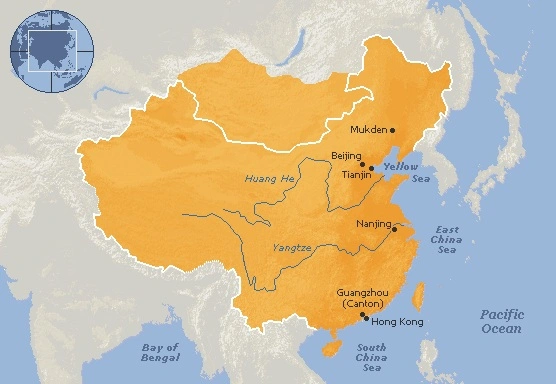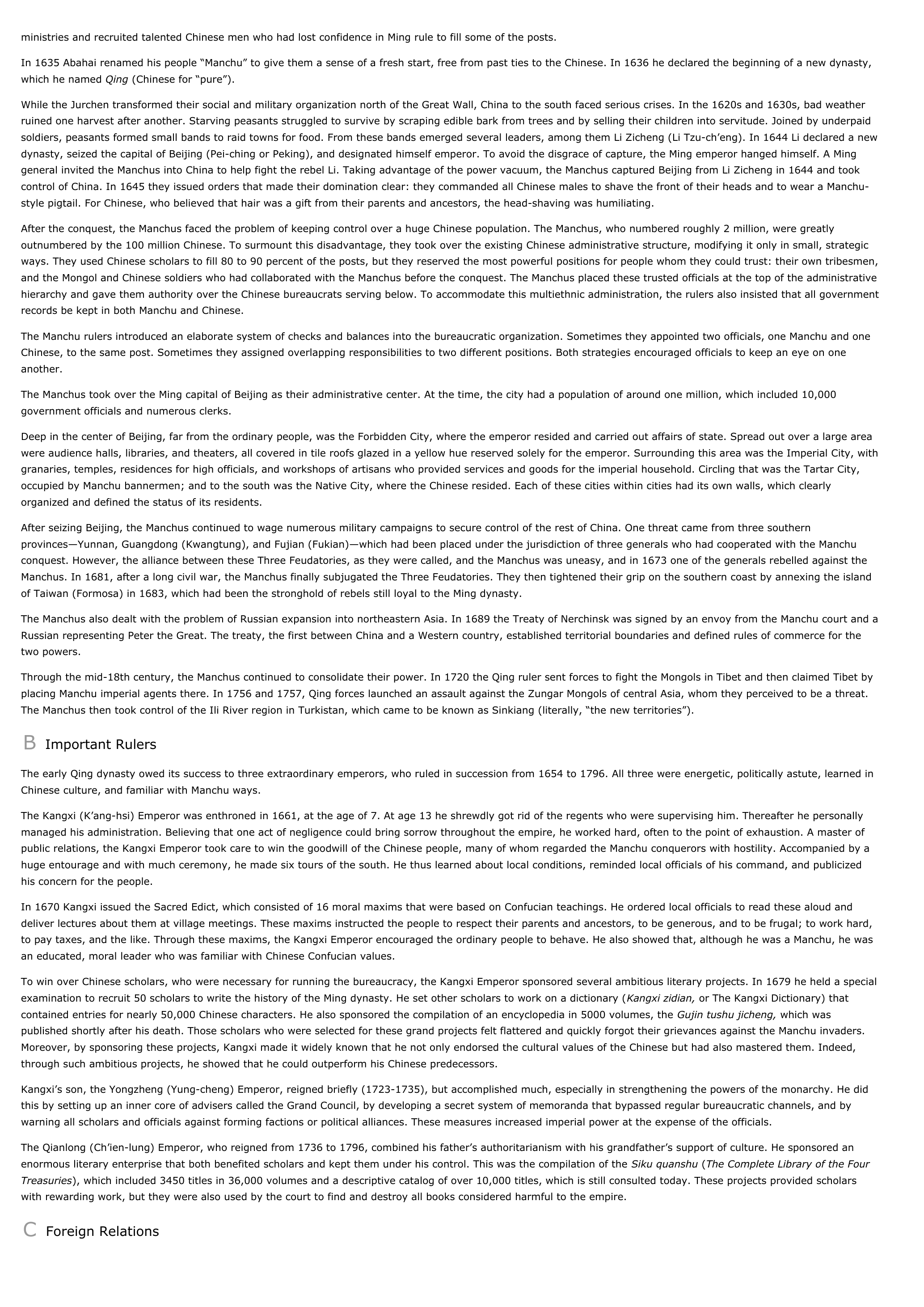Qing Dynasty - history.
Publié le 26/05/2013

Extrait du document


«
ministries and recruited talented Chinese men who had lost confidence in Ming rule to fill some of the posts.
In 1635 Abahai renamed his people “Manchu” to give them a sense of a fresh start, free from past ties to the Chinese.
In 1636 he declared the beginning of a new dynasty,which he named Qing (Chinese for “pure”).
While the Jurchen transformed their social and military organization north of the Great Wall, China to the south faced serious crises.
In the 1620s and 1630s, bad weatherruined one harvest after another.
Starving peasants struggled to survive by scraping edible bark from trees and by selling their children into servitude.
Joined by underpaidsoldiers, peasants formed small bands to raid towns for food.
From these bands emerged several leaders, among them Li Zicheng (Li Tzu-ch’eng).
In 1644 Li declared a newdynasty, seized the capital of Beijing (Pei-ching or Peking), and designated himself emperor.
To avoid the disgrace of capture, the Ming emperor hanged himself.
A Minggeneral invited the Manchus into China to help fight the rebel Li.
Taking advantage of the power vacuum, the Manchus captured Beijing from Li Zicheng in 1644 and tookcontrol of China.
In 1645 they issued orders that made their domination clear: they commanded all Chinese males to shave the front of their heads and to wear a Manchu-style pigtail.
For Chinese, who believed that hair was a gift from their parents and ancestors, the head-shaving was humiliating.
After the conquest, the Manchus faced the problem of keeping control over a huge Chinese population.
The Manchus, who numbered roughly 2 million, were greatlyoutnumbered by the 100 million Chinese.
To surmount this disadvantage, they took over the existing Chinese administrative structure, modifying it only in small, strategicways.
They used Chinese scholars to fill 80 to 90 percent of the posts, but they reserved the most powerful positions for people whom they could trust: their own tribesmen,and the Mongol and Chinese soldiers who had collaborated with the Manchus before the conquest.
The Manchus placed these trusted officials at the top of the administrativehierarchy and gave them authority over the Chinese bureaucrats serving below.
To accommodate this multiethnic administration, the rulers also insisted that all governmentrecords be kept in both Manchu and Chinese.
The Manchu rulers introduced an elaborate system of checks and balances into the bureaucratic organization.
Sometimes they appointed two officials, one Manchu and oneChinese, to the same post.
Sometimes they assigned overlapping responsibilities to two different positions.
Both strategies encouraged officials to keep an eye on oneanother.
The Manchus took over the Ming capital of Beijing as their administrative center.
At the time, the city had a population of around one million, which included 10,000government officials and numerous clerks.
Deep in the center of Beijing, far from the ordinary people, was the Forbidden City, where the emperor resided and carried out affairs of state.
Spread out over a large areawere audience halls, libraries, and theaters, all covered in tile roofs glazed in a yellow hue reserved solely for the emperor.
Surrounding this area was the Imperial City, withgranaries, temples, residences for high officials, and workshops of artisans who provided services and goods for the imperial household.
Circling that was the Tartar City,occupied by Manchu bannermen; and to the south was the Native City, where the Chinese resided.
Each of these cities within cities had its own walls, which clearlyorganized and defined the status of its residents.
After seizing Beijing, the Manchus continued to wage numerous military campaigns to secure control of the rest of China.
One threat came from three southernprovinces—Yunnan, Guangdong (Kwangtung), and Fujian (Fukian)—which had been placed under the jurisdiction of three generals who had cooperated with the Manchuconquest.
However, the alliance between these Three Feudatories, as they were called, and the Manchus was uneasy, and in 1673 one of the generals rebelled against theManchus.
In 1681, after a long civil war, the Manchus finally subjugated the Three Feudatories.
They then tightened their grip on the southern coast by annexing the islandof Taiwan (Formosa) in 1683, which had been the stronghold of rebels still loyal to the Ming dynasty.
The Manchus also dealt with the problem of Russian expansion into northeastern Asia.
In 1689 the Treaty of Nerchinsk was signed by an envoy from the Manchu court and aRussian representing Peter the Great.
The treaty, the first between China and a Western country, established territorial boundaries and defined rules of commerce for thetwo powers.
Through the mid-18th century, the Manchus continued to consolidate their power.
In 1720 the Qing ruler sent forces to fight the Mongols in Tibet and then claimed Tibet byplacing Manchu imperial agents there.
In 1756 and 1757, Qing forces launched an assault against the Zungar Mongols of central Asia, whom they perceived to be a threat.The Manchus then took control of the Ili River region in Turkistan, which came to be known as Sinkiang (literally, “the new territories”).
B Important Rulers
The early Qing dynasty owed its success to three extraordinary emperors, who ruled in succession from 1654 to 1796.
All three were energetic, politically astute, learned inChinese culture, and familiar with Manchu ways.
The Kangxi (K’ang-hsi) Emperor was enthroned in 1661, at the age of 7.
At age 13 he shrewdly got rid of the regents who were supervising him.
Thereafter he personallymanaged his administration.
Believing that one act of negligence could bring sorrow throughout the empire, he worked hard, often to the point of exhaustion.
A master ofpublic relations, the Kangxi Emperor took care to win the goodwill of the Chinese people, many of whom regarded the Manchu conquerors with hostility.
Accompanied by ahuge entourage and with much ceremony, he made six tours of the south.
He thus learned about local conditions, reminded local officials of his command, and publicizedhis concern for the people.
In 1670 Kangxi issued the Sacred Edict, which consisted of 16 moral maxims that were based on Confucian teachings.
He ordered local officials to read these aloud anddeliver lectures about them at village meetings.
These maxims instructed the people to respect their parents and ancestors, to be generous, and to be frugal; to work hard,to pay taxes, and the like.
Through these maxims, the Kangxi Emperor encouraged the ordinary people to behave.
He also showed that, although he was a Manchu, he wasan educated, moral leader who was familiar with Chinese Confucian values.
To win over Chinese scholars, who were necessary for running the bureaucracy, the Kangxi Emperor sponsored several ambitious literary projects.
In 1679 he held a specialexamination to recruit 50 scholars to write the history of the Ming dynasty.
He set other scholars to work on a dictionary ( Kangxi zidian, or The Kangxi Dictionary) that contained entries for nearly 50,000 Chinese characters.
He also sponsored the compilation of an encyclopedia in 5000 volumes, the Gujin tushu jicheng, which was published shortly after his death.
Those scholars who were selected for these grand projects felt flattered and quickly forgot their grievances against the Manchu invaders.Moreover, by sponsoring these projects, Kangxi made it widely known that he not only endorsed the cultural values of the Chinese but had also mastered them.
Indeed,through such ambitious projects, he showed that he could outperform his Chinese predecessors.
Kangxi’s son, the Yongzheng (Yung-cheng) Emperor, reigned briefly (1723-1735), but accomplished much, especially in strengthening the powers of the monarchy.
He didthis by setting up an inner core of advisers called the Grand Council, by developing a secret system of memoranda that bypassed regular bureaucratic channels, and bywarning all scholars and officials against forming factions or political alliances.
These measures increased imperial power at the expense of the officials.
The Qianlong (Ch’ien-lung) Emperor, who reigned from 1736 to 1796, combined his father’s authoritarianism with his grandfather’s support of culture.
He sponsored anenormous literary enterprise that both benefited scholars and kept them under his control.
This was the compilation of the Siku quanshu (The Complete Library of the Four Treasuries ), which included 3450 titles in 36,000 volumes and a descriptive catalog of over 10,000 titles, which is still consulted today.
These projects provided scholars with rewarding work, but they were also used by the court to find and destroy all books considered harmful to the empire.
C Foreign Relations.
»
↓↓↓ APERÇU DU DOCUMENT ↓↓↓
Liens utiles
- Qing Dynasty - History.
- Han Dynasty - history.
- Shang Dynasty - history.
- Qin Dynasty - history.
- Han Dynasty - history.





